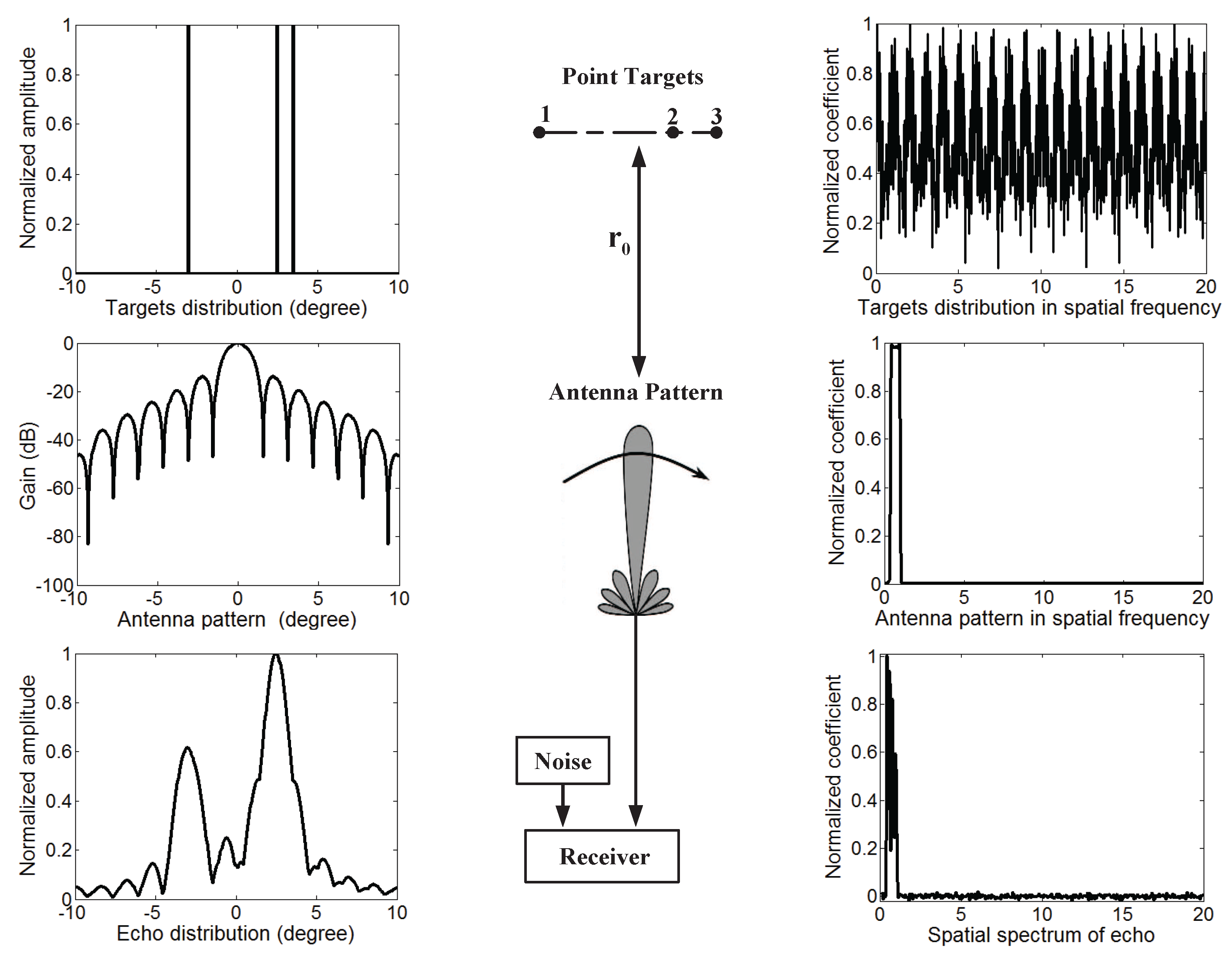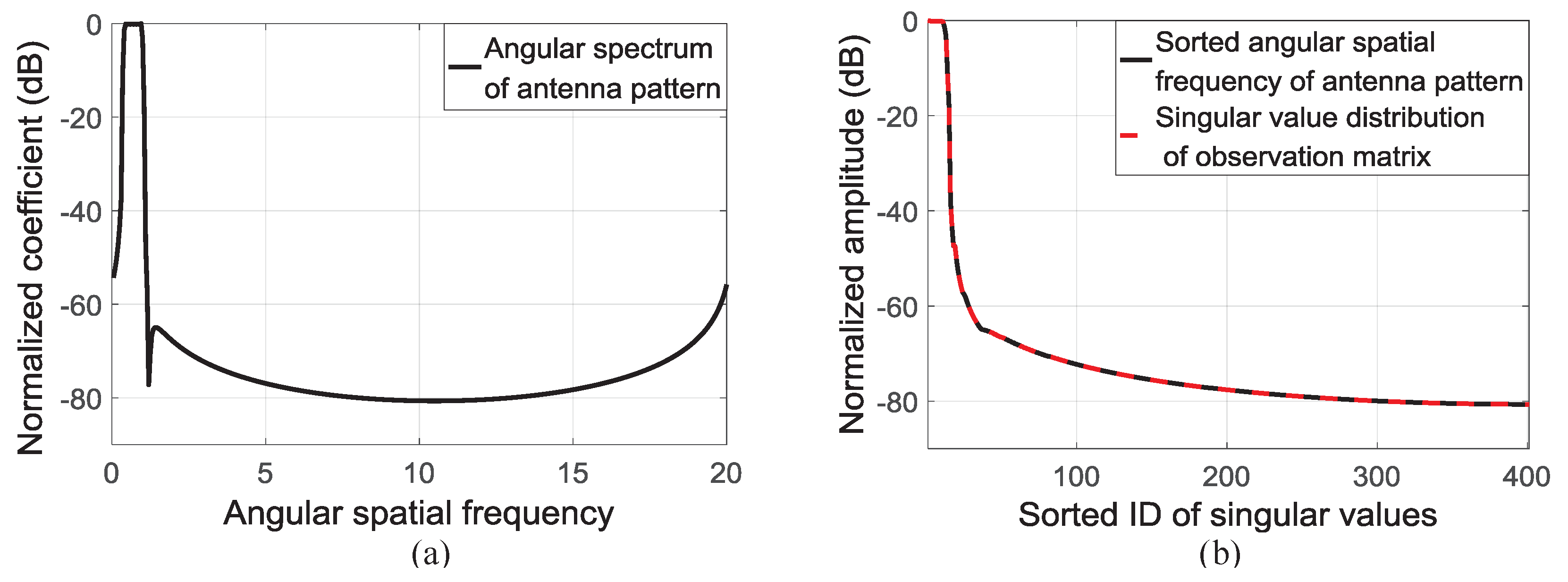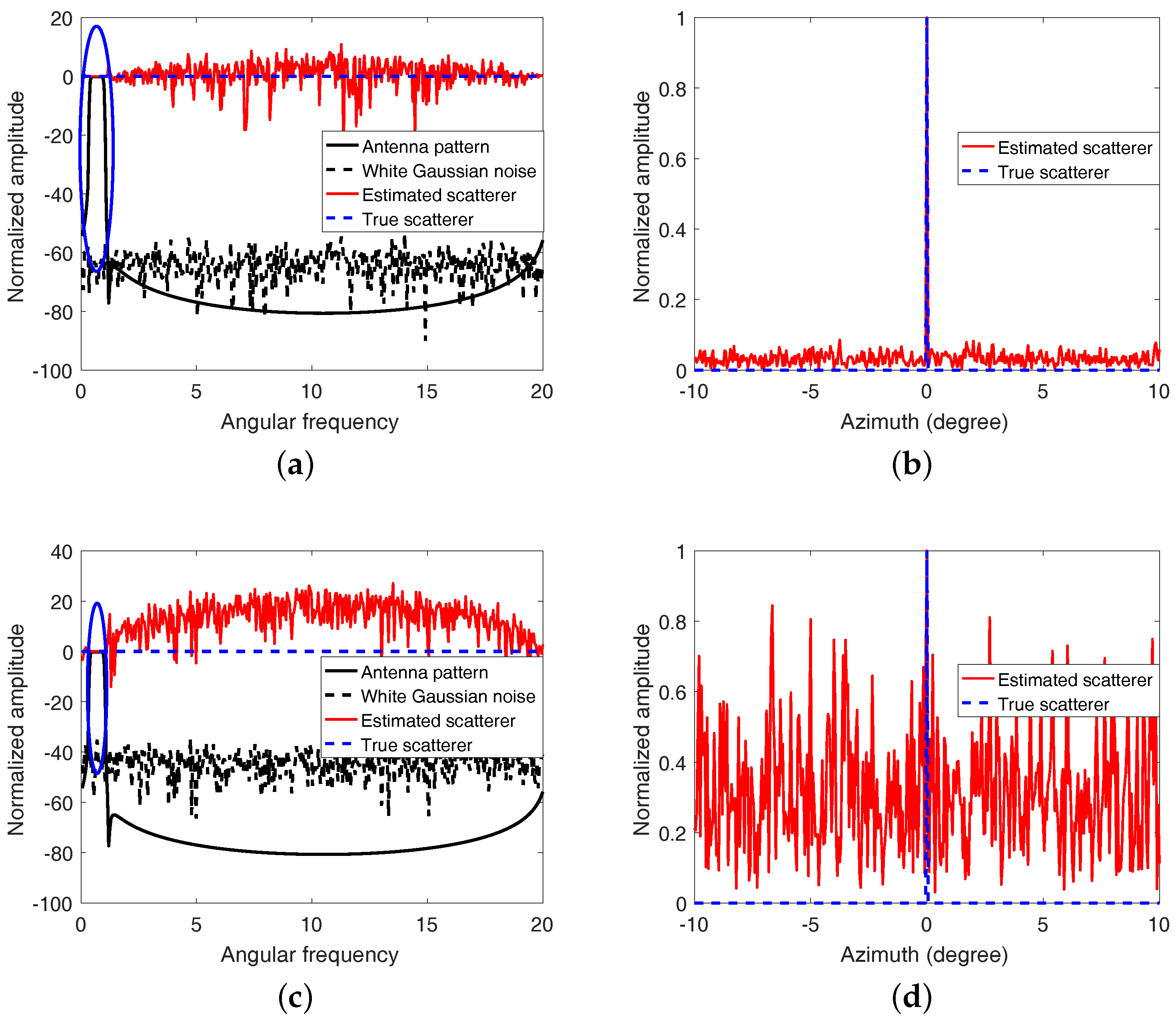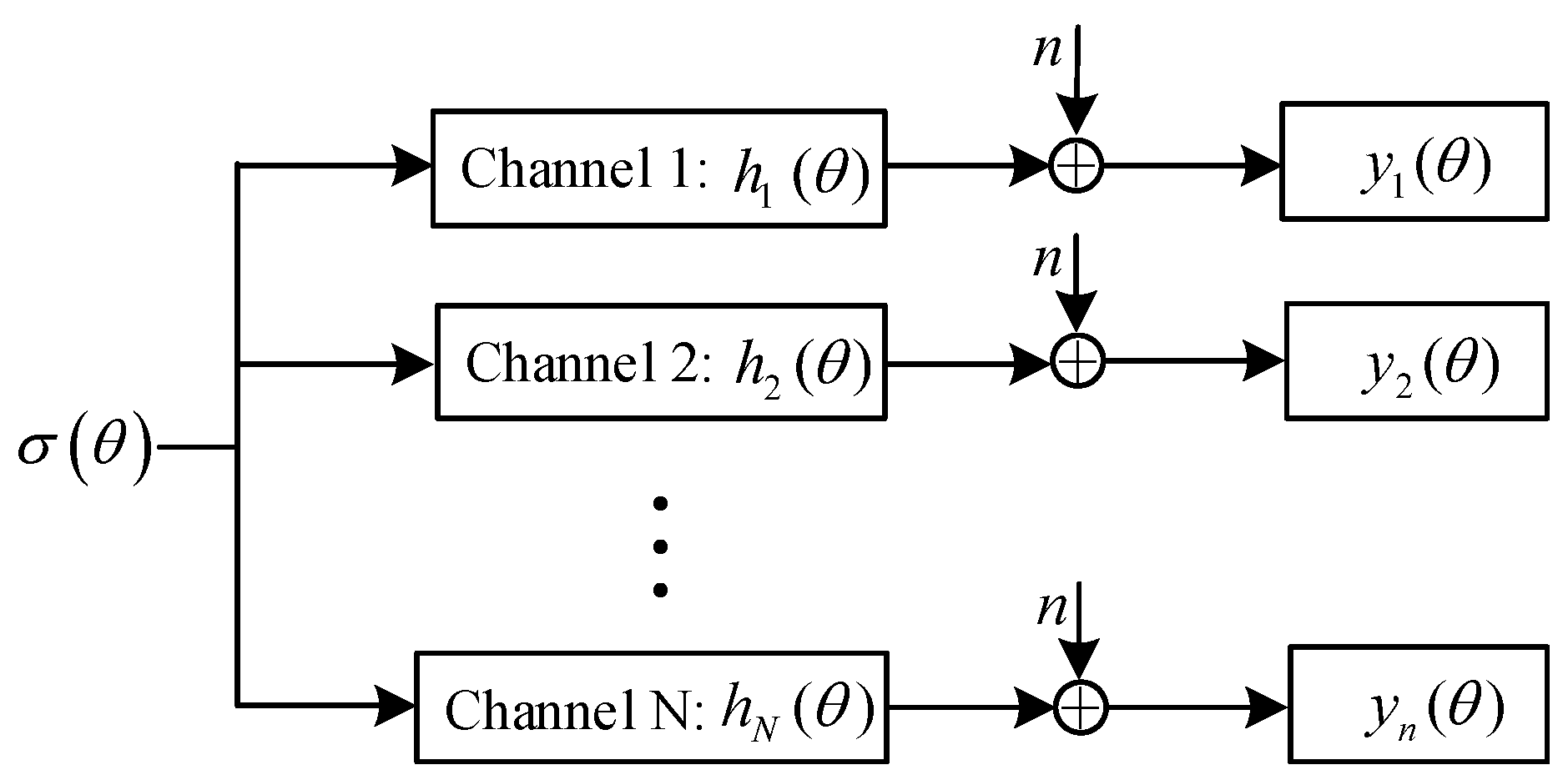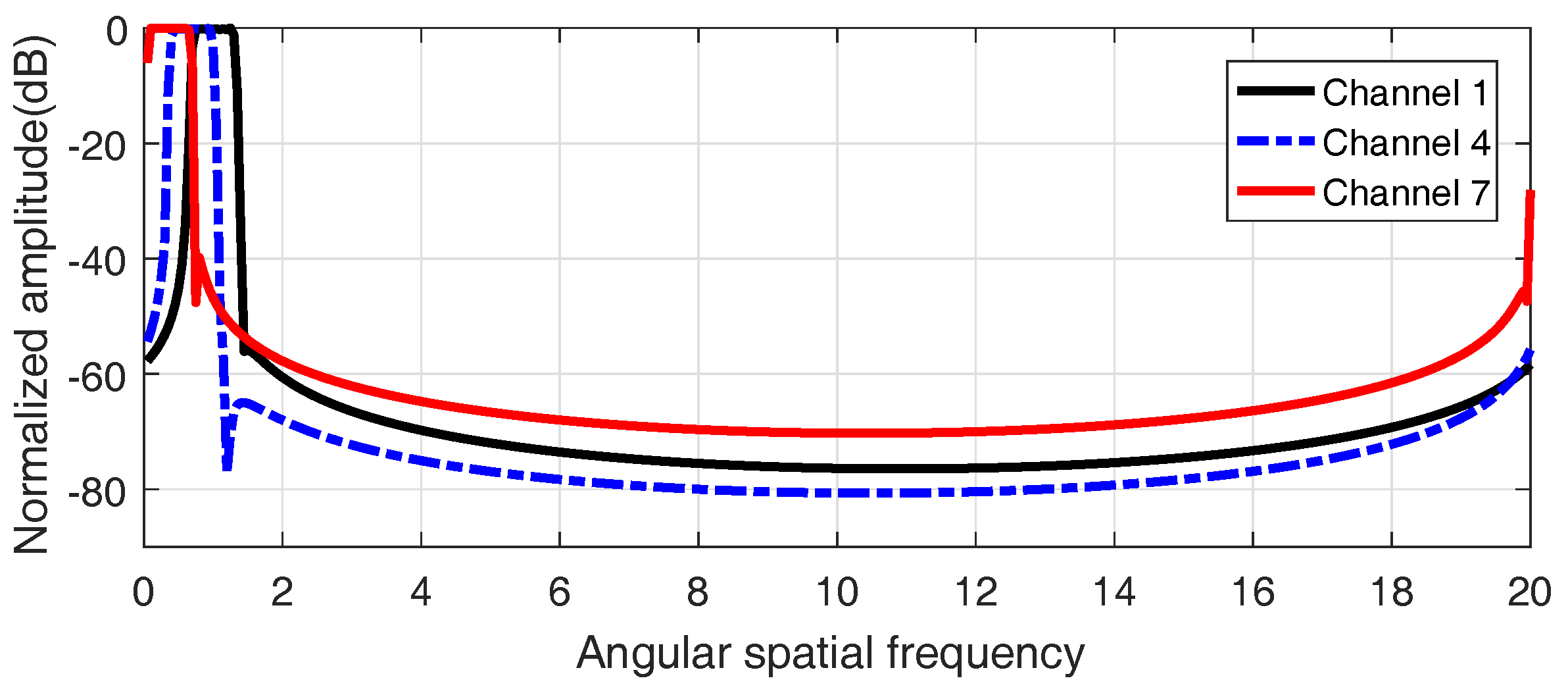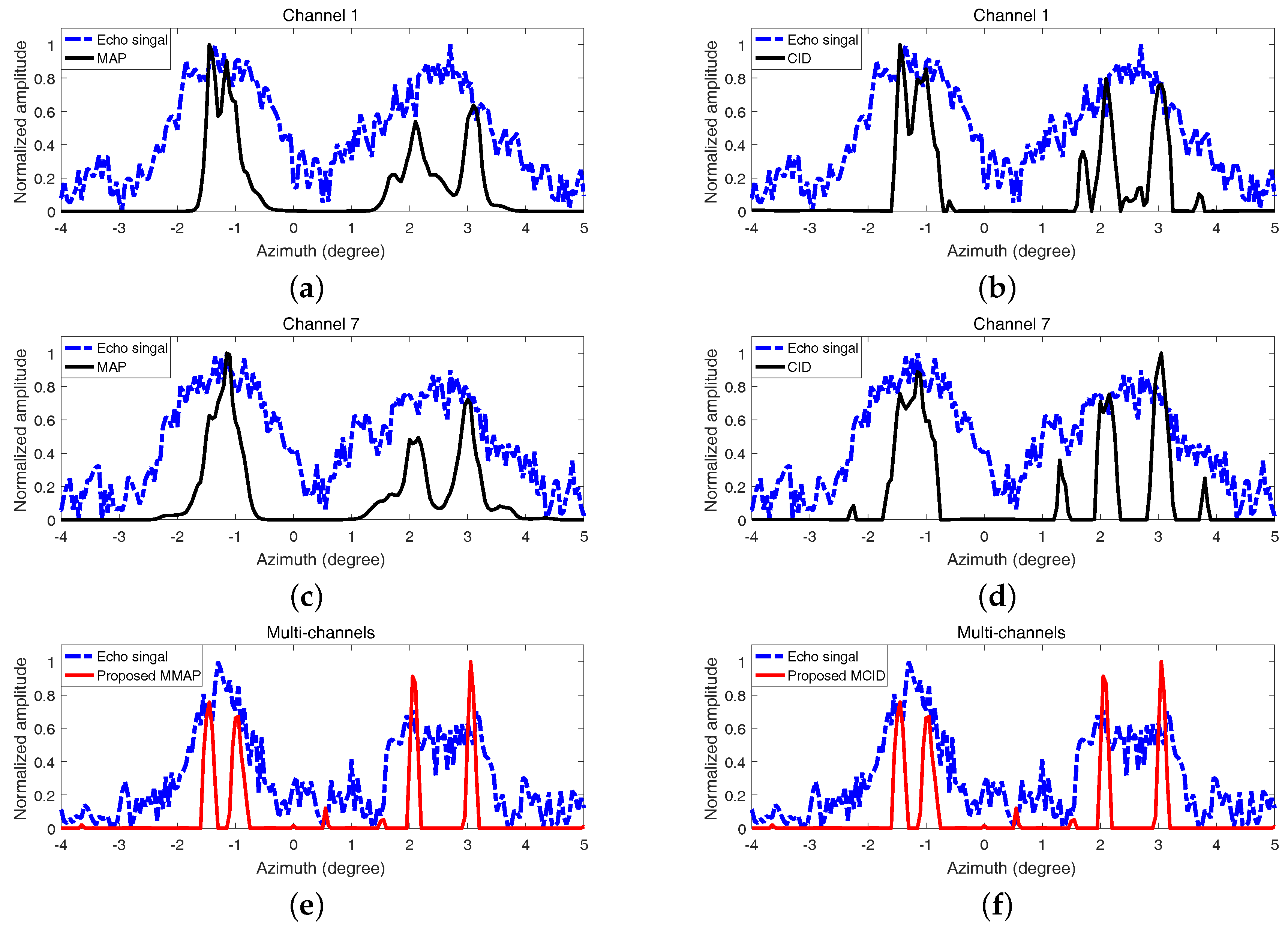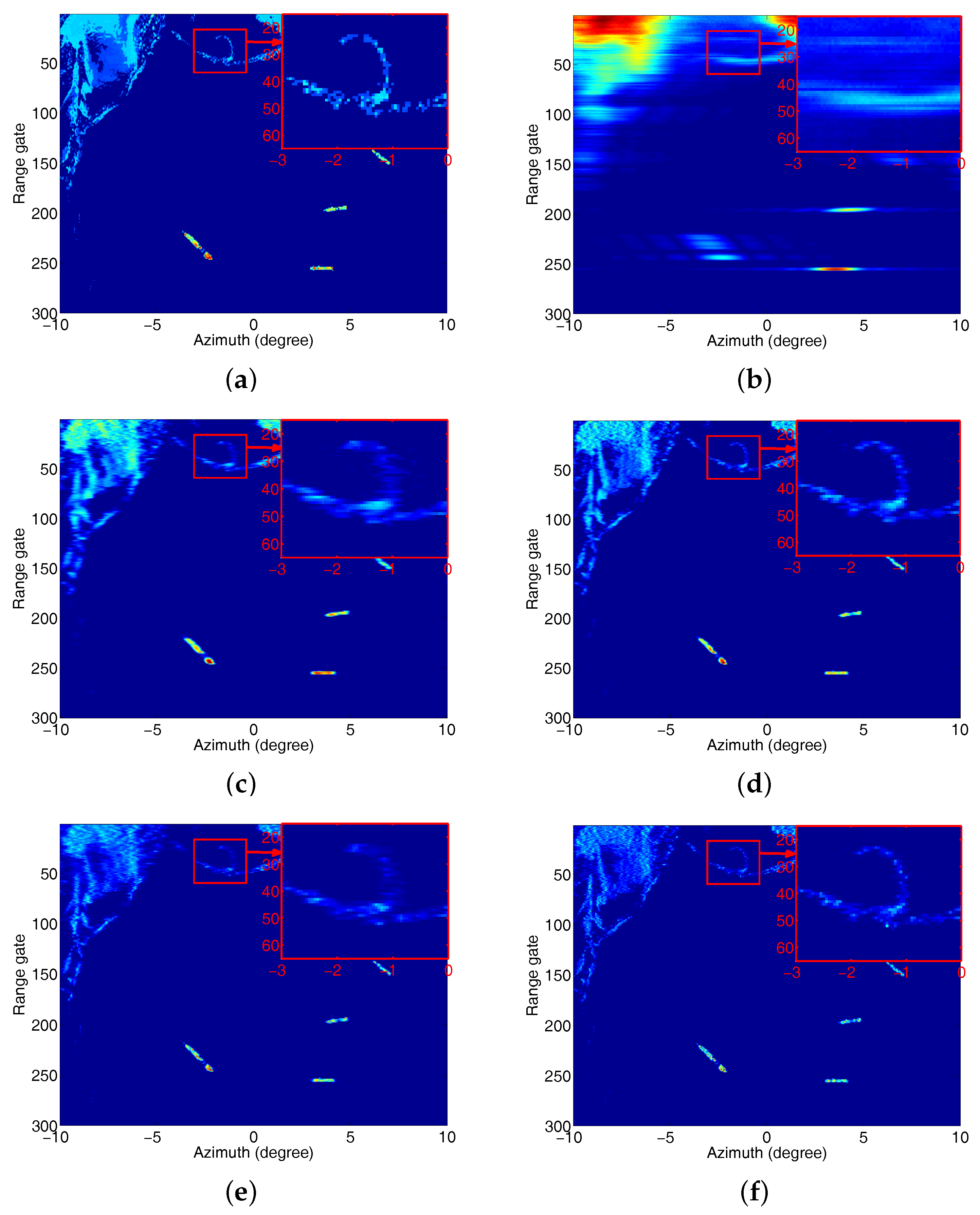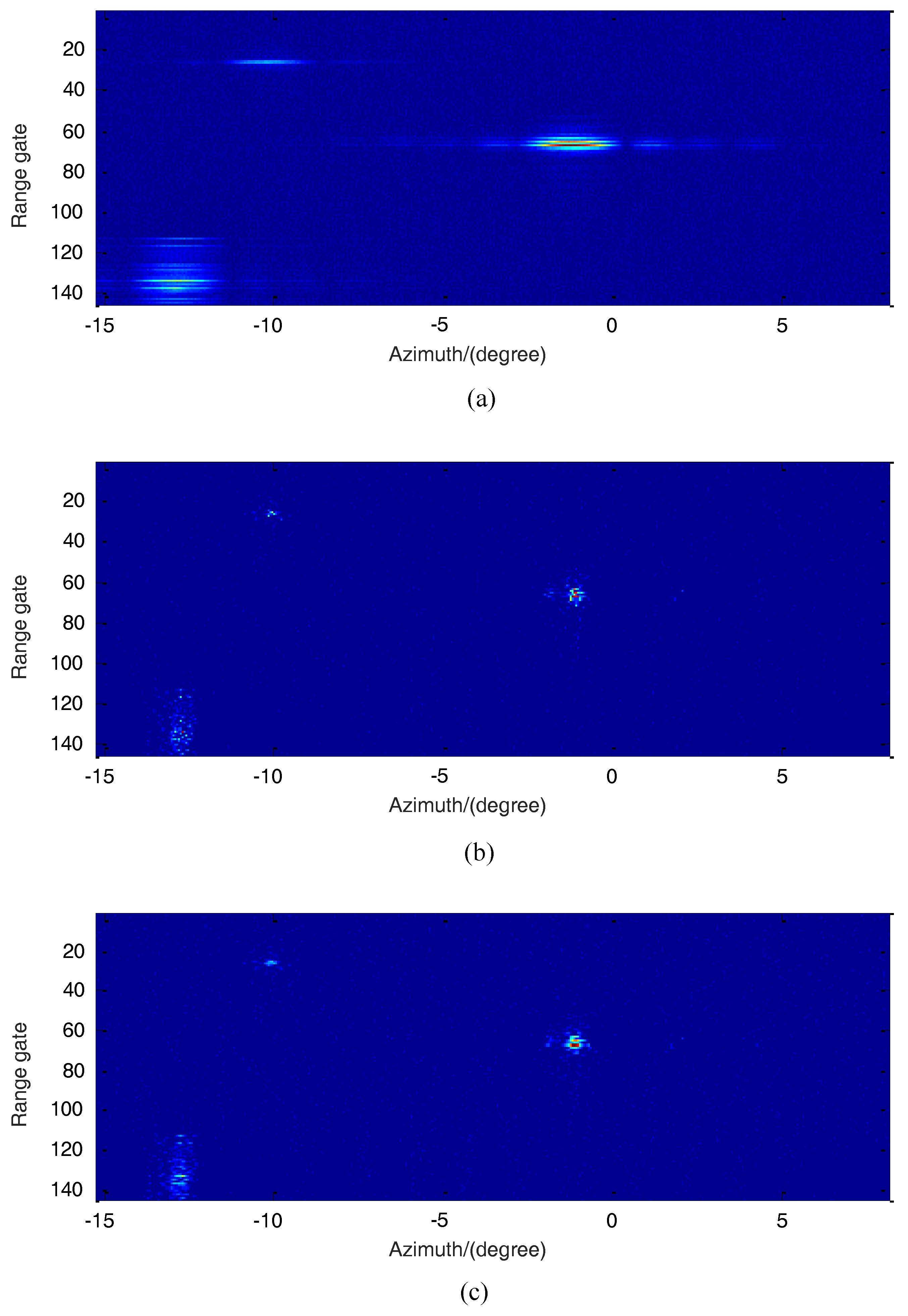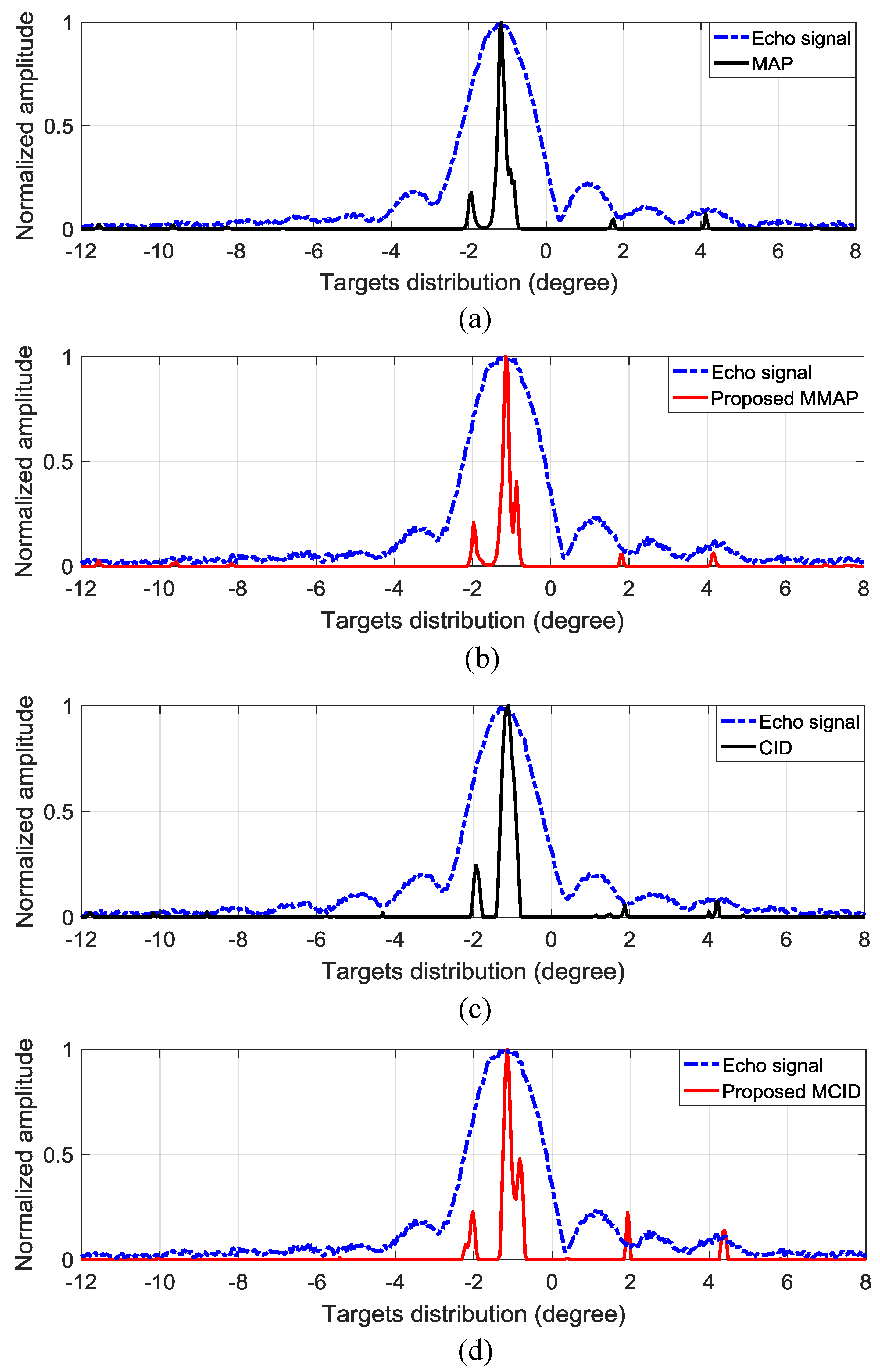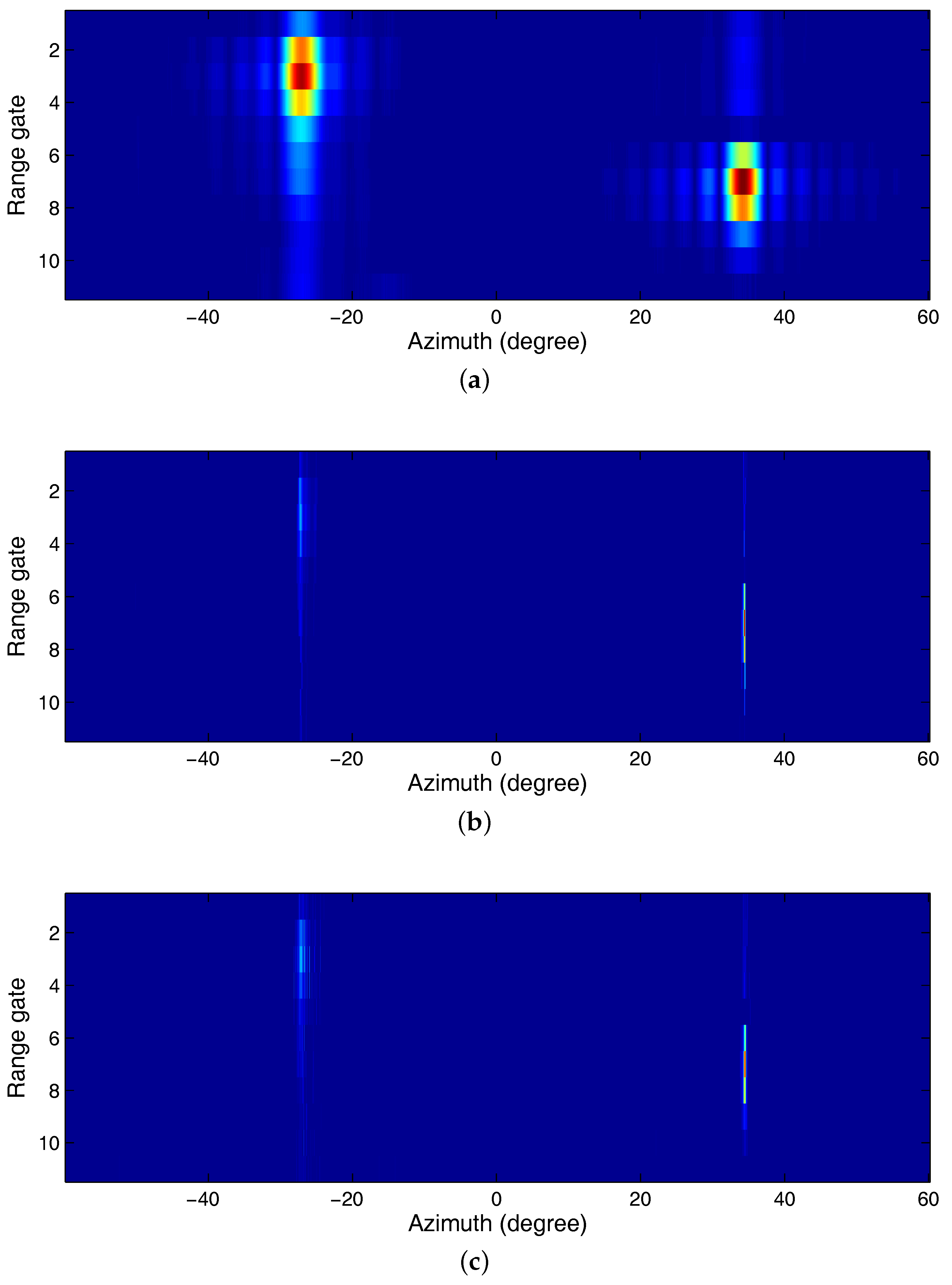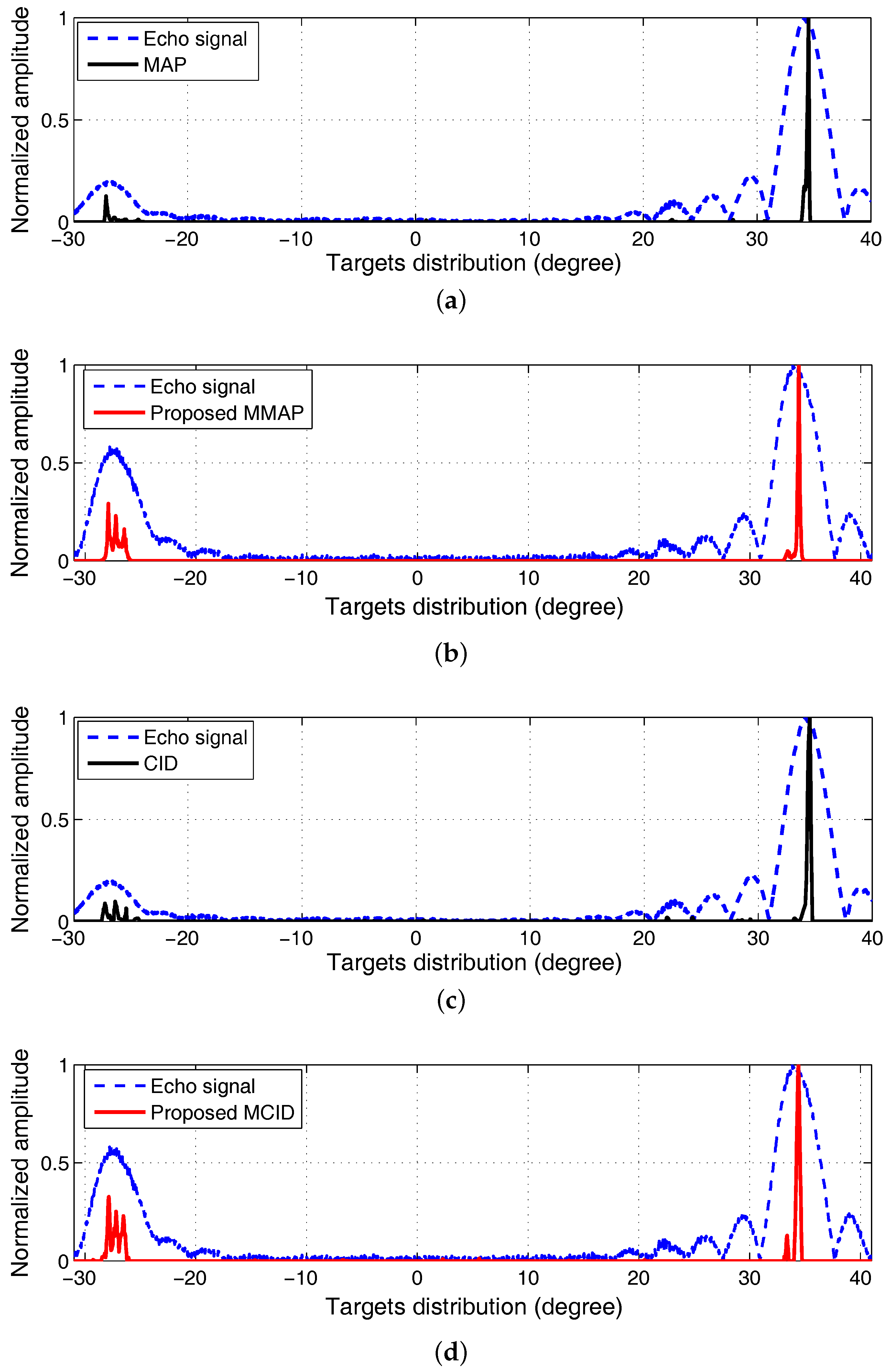1. Introduction
Synthetic aperture radar (SAR) and Doppler beam sharpening (DBS) have a wide range of applications on civil and military fields to achieve high cross-range resolution [
1,
2,
3,
4,
5,
6]. However, traditional SAR and DBS cannot focus on the area along the flight direction with high azimuth resolution due to the symmetrical and small Doppler bandwidth. Bistatic forward-looking SAR (BFSAR) can break through the limitations of traditional monostatic SAR and achieve high-resolution imaging of forward-looking terrain. However, it is difficult to implement in practice due to the large range cell migration (RCM) and 2-D variation of Doppler characteristics [
7]. In the forward-looking area, phased array radar (PAR) based on scanning radar imaging is widely used. The angular resolution
is limited by the real aperture size
D with
for a raw PAR imaging system, where
is the wavelength [
8]. Thus, approaches to improving angular resolution include enlarging physical antenna aperture and increasing emission frequency, but constrained by the antenna weight, size and other physical factors.
Since the received signal in azimuth can be modeled as a mathematical convolution of targets’ scattering coefficients and antenna pattern, deconvolution is an efficient method to achieve angular super-resolution [
9]. Unfortunately, deconvolution is inherently an ill-posed problem under noise environment that typically involves a great number of unknowns due to the receiver noise and low-pass characteristic of antenna pattern, which brings about amplifying system noise and blurring effects [
10,
11,
12,
13,
14,
15,
16,
17]. Recently, deconvolution algorithms in Bayesian framework or sparse signal reconstruction have been used in the application of radar imaging to improve cross-range resolution [
18,
19,
20,
21,
22,
23,
24,
25,
26,
27], but the tradeoff between robustness and resolution performance cannot be easily adjusted. In [
28,
29,
30], a constrained iterative deconvolution (CID) algorithm was proposed to obtain well-behaved results due to positive constraint, but the angular resolution improvement is still limited by noise when the signal-to-noise ratio (SNR) is relatively low. Most of deconvolution algorithms are performed in the case of single channel thus the performance of deconvolution isn’t very well. Actually, multi-channel deconvolution for monopulse radar has been proposed for ameliorating the ill-posed problem [
31,
32]. The multikernel deconvolution was implemented by an inverse filter using filter coefficients derived by linear programming in [
31], it was concluded that antenna sidelobe, scanning rate were the main factors which influence the SNR after deconvolution for monopulse radar. Furthermore, [
32] studied and emphasized the form of truncated antenna pattern, but the simulation results showed that the recovery result was seriously contaminated by noise. Above research about multi-channel monopulse radar imaging cannot be directly applied to scanning radar, the impact of antenna sidelobe, scanning rate and form of truncated antenna pattern on deconvolution method is not so significant for scanning radar. There are few papers about multi-channel deconvolution for PAR imaging while the performance of single-channel deconvolution for scanning radar imaging is still far from satisfactory. The multi-channel deconvolution may improve the imaging robustness and practicability while further increase the angular resolution. Therefore, our research focus on multi-channel deconvolution methods for forward-looking scanning radar imaging in this paper. Furthermore, the poor characteristic of singular value property for observation matrix or spectrum for antenna pattern is inherently dominant to the ill-posed problem of super-resolution. Thus, it is worth studying how above characteristics specifically affect and ameliorate the deconvolution problem when multiple channels are exploited.
Attentive to the aforementioned consideration, we propose multi-channel deconvolution methods to achieve angular super-resolution, which intend to ameliorate the ill-condition problem of single-channel deconvolution. The characteristics of antenna pattern and observation matrix, which are generalized as three effective measurement factors, conduct us to measure the gain by rational use of multiple channels. The framework of this paper is organized as follows:
Section 2 briefly establishes the imaging model for forward-looking PAR system.
Section 3 reviews the ill-condition problem of deconvolution. Relationship of angular spatial spectrum of antenna pattern and singular value distribution of observation matrix will be discussed with evaluation parameters to describe the performance of deconvolution problem. After establishing multi-channel deconvolution model in
Section 4, we will present two multi-channel deconvolution algorithms, termed as multi-channel maximum a posteriori-based deconvolution (MMAP) and multi-channel constrained iterative deconvolution (MCID), which improve upon the traditional MAP [
19,
20] and CID [
28,
29,
30] algorithm via combining with multi-channel deconvolution technique. In
Section 5, extensive simulated and real measured data are presented to validate the effectiveness of proposed methods. Finally, conclusions are drawn in
Section 6.
Notations used in this paper are as follows: Bold-case letters are reserved for vectors and matrices, e.g., is a vector, is a matrix. is the convolution operation. is a diagonal matrix with its diagonal entries being the entries of vector . and are Fourier and inverse Fourier transform. , , and denote the transpose, conjugate transpose, conjugate and inverse operation, respectively.
2. Mathematical Model of Signal
Consider the PAR transmitting the linear frequency-modulated (LFM) signal, the received signal after motion compensation and range compression for one target with position
can be written as [
33]:
where
t is the fast time in range,
is the azimuth time,
is the target’s scattering coefficient.
c is the velocity of electromagnetic wave,
is the antenna pattern,
B and
denote the bandwidth and wavelength of transmitted signal, respectively.
is the sinc function and defined as
.
Since
and
, where
is the scanning speed of antenna,
r is the range variation. Ignoring the constant terms when only considering the azimuth variation for a fixed range
:
The received signal is the superposition integral of all the scattered waves in one range bin, considering the effect of noise
, one can obtain:
In the angular frequency domain, (3) is recast as:
where
,
,
and
are the Fourier transforms of
,
,
and
respectively, and
is the angular spatial frequency.
The received signal (3) could also be expressed in vector form as:
where
,
,
represent the received signal, targets’ scattering coefficients and noise vector with size
, respectively. The matrix
is the convolution operation matrix formed by
, which can be expressed as [
34]:
The diagram of signal model for the PAR system is illustrated in
Figure 1, the scanning radar works in a typical forward-looking mode. As shown in
Figure 1, the PAR scans a region that contains three point targets, and the received signal is the convolution result of the targets’ scattering coefficients and the antenna pattern. The left part of
Figure 1 shows the characteristic of
,
,
, and right part presents
,
,
. The antenna pattern corresponds to the angular impulse response which can be seen as a low-pass filter. The echo is proportional to the antenna pattern and only remains the low frequency information which reduces the angular resolution intensely. Since the targets’ distribution is smoothed by the antenna beam, isolated targets become obscure, and adjacent targets cannot be distinguished.
3. Ill-Posed Problem of Deconvolution
The mathematical signal model suggests that the targets’ scattering information could be restored by deconvolution or inverse filter. Unfortunately, deconvolution is equivalent to a linear inverse problem, which is essentially an ill-posed problem in most practical application scenarios due to the disturbance of noise and low-pass characteristic of antenna pattern. The direct solution of the inverse system without reducing the effects of noise will amplify system noise and bring blurring effects clearly.
The research of ill-posed problem for deconvolution is the necessary prerequisite to super-resolution imaging, which is divided into two parts in detail as follows: Firstly, the essential corresponding relation between angular spectrum of antenna pattern and singular value decomposition (SVD) [
35,
36] of observation matrix is introduced briefly to better describe the deconvolution problem. Then, in order to get more detailed information and compare different deconvolution systems, three evaluation parameters will be served to evaluate the property of observation matrix.
3.1. Angular Spatial Spectrum of Antenna Pattern and Singular Value Decomposition of Observation Matrix
As (
6) shows, the convolution operation matrix
is a circulant matrix composed of antenna pattern
, thus the Fourier transform coefficient of
is the eigenvalue of observation matrix
, and the corresponding eigenvector of
is the Fourier transform base.
What’s more, the singular value of matrix
is the positive square root of the eigenvalue of the matrix
. Since
has the conjugated-symmetrical structure, the singular value of observation matrix
is equal to the amplitude of angular spectrum of antenna pattern
, i.e.,
The simulation results illustrated in
Figure 2 support above conclusion.
Figure 2a shows the angular spectrum of antenna pattern. Red dotted line in
Figure 2b draws the distribution of sorted singular values. It is disadvantageous to the comparative analysis under different transverse coordinates, so
Figure 2b gives the sorted results of angular spectrum for antenna pattern in black solid line. The coincident curves demonstrate the equivalence of them, furthermore, the small singular values generally represent the high frequency information by comparing
Figure 2a,b.
Theoretically, we can restore the targets’ scattering information according to (
4) by direct deconvolution:
The recovery results are different with the true targets because of the last term
. As shown in
Figure 3, even if slight noise will cause tremendous consequences due to the division operation by small singular values, which results in the ill-posed problem of angular super-resolution. Here, we circle distribution set of effective singular values with blue ellipse: (1) Small singular values cannot be utilized to increase resolution effectively but amplify noise to an unacceptable level. Comparing
Figure 3b,d, we can find that the noise amplification becomes more serious with the deterioration of SNR from 65 dB to 45 dB. Especially in
Figure 3c, erroneous results dramatically increase to 35 dB with the increase of noise, which have covered up the useful information and ruined the reconstruction results. (2) Large singular values can be used for recovering scatterers’ information precisely, which can be seen from
Figure 3a,c that the recovery results are almost coincident with the accurate results. However, they cannot further improve the angular resolution since the large singular values correspond to the low frequency information.
3.2. Evaluation Criteria of Deconvolution Problem
Through above analysis, we notice that the ill-posed problem of deconvolution is derived from the non-uniform distribution of singular values. In order to measure the performance of different deconvolution systems, objective assessment parameters are given to evaluate the deconvolution matrix .
The first parameter is condition number, which is an important index to measure the numerical stability of linear equation. The definition of condition number [
37] of
is:
where
is the largest singular value and
is the smallest singular value. The condition number of
in
Figure 2b is 80.67 dB, thus direct deconvolution is a severely ill-posed problem.
Besides the difference between minimum and maximum singular values, the average of singular values is significant for inverse system as well, which can represent the magnification of noise after direct deconvolution. The noise
is assumed as stationary, zero mean, white, and Gaussian, with
The output noise variance
after deconvolution can be written as follow according to (8):
Substituting (
10) into (
11):
After normalization, we can use
to characterize the magnification of system noise after deconvolution:
The output SNR after direct deconvolution for
Figure 2b will decline 103.7 dB.
Most importantly, we also want to obtain the percentage of effective singular values, which also can be viewed as bandwidth of passband, defined as:
where
I meets following requirements:
and
.
is associated with signal-to-noise ratio circumstance. The
of
Figure 2b is 3.74%, which means the percentage of effective singular values is about 3.74% when SNR is 30 dB. In particular, this parameter will drop constantly with the increase of noise level.
4. Multi-Channel Deconvolution
Deconvolution of single-channel convolution equation is intractable and sensitive to noise, but the inversion of a set of simultaneous convolution equations may ameliorate the ill-condition problem of single-channel deconvolution. Existing researches on multi-channel deconvolution are limited to monopulse radar [
31,
32] which is distinguished from phased array scanning radar: (1) The major concerns including the antenna sidelobe, scanning rate and form of truncated antenna pattern are of little importance to the deconvolution problem for phased array scanning radar. (2) The multi-channel deconvolution methods of above researches are so simple that cannot handle noise well, so it is difficult to be applied to practical solutions, such as inverse filter or Wiener filter. In this section, we will establish multi-channel deconvolution model and propose multi-channel deconvolution methods to achieve angular super-resolution for phased array scanning radar. Comparing the multi-channel with single-channel by evaluating various performances of angular impulse response or convolution matrix with proposed evaluation criteria, we will analyse the gain acquired by multi-channel system.
4.1. Multi-channel Deconvolution Model
The imaging model of multi-channel forward-looking scanning radar is illustrated in
Figure 4. The received echo of each channel in angular frequency domain can be expressed as:
where
is the antenna pattern of channel
i,
is the spatial spectrum of
. The sum of above Equations (
15) can be written as:
Targets’ azimuthal scattering coefficients can be calculated by following formula:
It can be noted that multi-channel deconvolution system changes the antenna pattern from to , which may bring improvements to the performance of deconvolution.
4.2. Multi-channel Deconvolution Analysis
As mentioned above, multi-channel deconvolution system is helpful to performance improvements compared with single-channel . In this section, we will illustrate this problem with uniform linear arrays.
For simplicity, we suppose there are two
M-elements uniform linear arrays with intersensor spacing
d working on wavelength
. There is a nonzero translation
between the two identical subarrays. Then the antenna pattern of first subarray can be obtained by:
where
.
Since the two subarrays have consistent formation, translation
makes the difference of phase shift between them. Thus the antenna pattern of second subarray is:
Considering the azimuth angle changes from
to
in forward-looking scanning radar imaging, we have approximate formula that
. Thus, (18) can be simplified as:
In addition, angular spectrum of
is:
Similarly, angular spectrum of
is:
It can be noted that the passband of two antennas is
with a translation
:
The improvement of effective singular values for multi-channel deconvolution system
can be written as:
Obviously, when , the synthesis channel will achieve the maximum bandwidth utilization. Multi-channel is superior to single-channel since wider passband implies more effective singular values, the increased effective singular values are favorable to restoring the targets’ scattering information, which is particularly important to the deconvolution system. The and are very difficult to calculate, so the criterion of constructing multi-channel system is to maximize pass-band bandwidth.
4.3. Multi-channel Deconvolution Method
The performance of multi-channel direct deconvolution algorithm is still affected by noise since we cannot effectively improve and , which means the ill-posed problem still exists. Inspired by above analysis, improved deconvolution methods are proposed based on the traditional algorithms via combining with multi-channel deconvolution technique to handle with the ill-posed problem and exploit the strengths of multiple channels.
In order to extend the single-channel deconvolution algorithm to multi-channel, we must consider the two expressions of multi-channel deconvolution for Equations (
4) and (
5). Although the two equations are equivalent for the same deconvolution model, there are some distinctions when designing the multi-channel deconvolution algorithms. Thus we propose MMAP algorithm for Equation (
5) based on [
20] and MCID algorithm for Equation (
4) based on [
28] to improve the angular resolution.
4.3.1. Multi-Channel Maximum A Posteriori-Based Deconvolution
According to Equation (
15), the received echoes could be expressed in vector form as:
Obviously, (
25) can be equivalently rewritten as following linear model:
where
where
is the echo vector of size
and the size of convolution operation matrix
is
, the increasing equations are conducive to a better performance of deconvolution. Nevertheless, large number of equations suffer from heavy computational burden, which cannot be tolerated in the real time processing system. To overcome above difficulty, we rewrite Equation (
25):
We can reformulate (
28) via inverse Fourier transform:
In addition, (
29) can be simplified as:
where
is defined as
and
is defined as
. Therefore, the received signal could be expressed in vector form:
where
,
,
are vectors of size
and the size of matrix
is
. It can be noted that the new convolution operation matrix of multi-channel is favorable to large-scale computing without extra calculation burden.
The estimated value for
, which satisfies the MAP criterion:
Referring to photon theory, the received signal
is measured by means of particles, in general, photons. In the case of radioactive decay, the measurement of photons is described by a Poisson distribution [
38]. Similarly, the Poisson distribution is an appropriate statistical model for the true scattering
likewise:
where
is the mean value of actual
ith value
in
,
is the mean value of the
j position in the scattering
[
39].
Substituting (33) into (32) and taking the logarithm of
, we can obtain the iterative formula [
20]:
Besides the Poisson distribution, sparse prior information based on compressed sensing has also been applied to forward-looking imaging since the number of strong scattering targets is sparse relative to the imaging area grids [
25,
26,
33]. However, sparse-based method can only serve as an auxiliary mean of imaging since it shows high sensitivity and unreliable performance in real data processing.
4.3.2. Multi-Channel Constrained Iterative Deconvolution
Then, we will introduce the proposed MCID method. After multiplied by the term
, Equation (
28) can be written as:
Above expression can be simplified as:
where
,
are the Fourier transforms of
,
, respectively.
The targets’ backscattering coefficients can be calculated by Landweber iteration [
40]:
where:
,
and
a satisfies
.
However, above result suffers from Gibbs’ oscillations and similar “ringing” artifacts caused by the absence of noise, which typically results in that the enhanced results have some negative values. To handle this problem, the positive constraint
is forced to the iterative intermediate value since the magnitude of
cannot be negative on physical grounds. The modified recursion can be written as follow [
28]:
5. Simulation and Real Data Processing
In this section, we present experimental results with simulation and real data to demonstrate the effectiveness of proposed deconvolution algorithms for angular super-resolution.
5.1. Multi-Channel Configuration
First of all, we give the configuration of multi-channel in simulation and real data processing. There are N channels with the same transmitter utilizing narrow beam but different receivers as
Figure 5 shows.
Each channel is composed of
-elements uniform linear array transmitter and
-elements linear array receiver with Hamming weighted, where
is the number of transmitter’s array elements and
is the number of receiver’s array elements. Channel 1, Channel
and Channel
N utilize the echo signal of the first, middle and last receiver, respectively. In addition, the difference lies in the space interval between receivers. The space interval between channel 1 and channel
is
and the space interval between Channel 1 and Channel
N is
, where
. Under the circumstance of
Figure 5, the beamwidth of antenna pattern mainly depends on the transmitter. Applying the same configuration of transmitter, expression (
24) is still applicable to this system:
and
, so it is unable to effectively utilize bandwidth. Fortunately,
will approach
with the increasing of
N.
In the simulation and experiments, there are 7 channels and the beamwidth of antenna pattern is
.
Figure 6 shows the angular spectrum of antenna pattern for different channels when
. As noted in
Figure 6, the angular spectrum of antenna patterns for different channels are distributed in different scopes. There is a little overlap between Channel 1 and 7, while the angular spectrum of Channel 4 overlaps neighboring Channel 1 and 7. The three objective assessment parameters are exploited to compare the capability of different systems in
Table 1.
Important conclusions of the multi-channel deconvolution systems are as follows:
Multi-channel system will have better performance than single-channel for the parameter , the increasing effective singular values are favorable to restoring the targets’ scattering information which is particularly important to the deconvolution system. Since there is less spectrum overlap between Channel 1 and 7, the result of Channel 1 and 7 is superior to Channel 1 and 4 due to the high bandwidth utilization. What’s more, the synthetic channel of all channels and Channel 1, 4 and 7 have the same quantity of bandwidth because the whole spectrum of Channel 4 is covered by Channel 1 and 7. The coincidence of partial pass band spectrum will result in unsatisfactory bandwidth utilization and unoptimal properties of deconvolution, which suppresses more useful high frequency information accordingly.
It is worth noting that the improvement of and is not obvious, which means that the ill-posed problem of deconvolution still exists. However, it doesn’t indicate that multiple channels provide little or no advantage on deconvolution system. Conversely, multiple channels have overwhelming dominance over individual channel since the richer information of effective singular values is conducive to angular super-resolution. Considering above three parameters, we can find the synthetic channel of Channel 1 and 7 achieves the best performance.
It should be pointed out that the superiority of multi-channel system is enhanced through increasing the aperture size as shown in expression (
24), thus the performance improvements will be still limited by the physical aperture of receivers. It was therefore not surprising that the performance of all channels has not been further improved than Channel 1 and 7, because the whole physical aperture can be obtained by Channel 1 and 7. Although these numerous redundant or overlapping information from all channels cannot ameliorate above three parameters, it will promote the SNR by improving signal power.
In practical application, comparing with single-channel, multi-channel deconvolution methods put forward some requirements on imaging system including channel uniformity and relatively complicated receiver circuit, a poor channel uniformity will not guarantee the reliability of the performance boost for multi-channel deconvolution. It needs to be clarified that since the multi-channel configuration is based on multi-channel receivers with the same transmitter and the cost of receiver is much cheaper than transmitter, multi-channel deconvolution won’t bring much hardware overhead. Therefore, multi-channel is worthy of study for the substantial benefits to the deconvolution problem.
5.2. Simulations
The multi-channel deconvolution system utilizes Channel 1 and Channel 7 in
Figure 6. The antenna pattern and the scattering information of targets are given by
Figure 7 and
Figure 8, and the 3 dB width of the real beam is about
. Angular spectrum of antenna pattern is shown in
Figure 8a. There are four targets located from
to
of the forward-looking area with azimuth position
,
,
and
in
Figure 8b. The antenna pattern of synthetic channel is illustrated in
Figure 8c according to expression (
29). The echo signal of multi-channel and single-channel are illustrated in
Figure 8d. After the convolution effect of antenna pattern, the high-frequency part of the true scene is lost which results in low resolution of received signal. Since there is little frequency spectrum overlap between Channel 1 and 7, the effective physical aperture of synthetic channel will be significantly improved. As noted in
Figure 8c, the beam width of synthetic channel is narrower than single-channel, more specifically, the beam width of synthetic channel is
of single-channel, which is conducive to beam sharpening and super-resolution. The improvements can be seen obviously from the comparison of echo signals in
Figure 8d: the multi-channel system can distinguish the adjacent targets while single-channel cannot.
In
Figure 9 and
Figure 10, we give the comparison charts of single-channel and proposed multi-channel deconvolution results with different Gaussian white noise. Compared with the received signals, the recovery results become clearer and distinguishable by removing the effect of antenna pattern. However, we can find that the noise influences the recovery results of single-channel from the top part and middle part of
Figure 9, which will cause many false targets while the proposed MCID and MMAP results suppress the false targets and obtain more reliable results as shown in the bottom part of
Figure 9. With the decrease of SNR, the performance degradation of single-channel deconvolution becomes more serious, the super-resolution result is distorted apparently and includes many false targets as shown in
Figure 10a–d. Meanwhile, the advantages of multi-channel become more apparent with the increasing noise as shown in
Figure 10e–f. Above gains in performance benefit from the increasing effective singular values of multi-channel, which are conducive to super-resolution imaging and mitigating the ill-posedness of deconvolution problem. It can be seen from
Figure 9 and
Figure 10 that the multi-channel deconvolution is less affected by SNR, which can keep performance of super-resolution with various conditions. Overall, compared with the traditional algorithm, simulation results prove that proposed algorithms have made some significant progress.
To quantitatively assess the quality of reconstructed images by different methods, the relative root mean square error (RMSE) of recovery result is utilized in
Figure 11. It can be seen from the Monte Carlo curves that the RMSE of multi-channel deconvolution is always lower than single-channel deconvolution, which verifies the superiority of proposed methods under different level of SNR. Therefore, the proposed algorithms have excellent stability and work practically in the engineering field.
Furthermore, scene simulations shown in
Figure 12 are made to evaluate the validity and effectiveness of proposed multi-channel deconvolution algorithms. The simulation parameters are listed in
Table 2.
Figure 12a is the original scene, including four ships, sea surface and coastline.
Figure 12b is the radar returned signal after pulse compression. It is clear that all targets are smoothed by the radar antenna pattern with a poor azimuth resolution.
Figure 12c,e are the MAP and CID results.
Figure 12d,f are the results of proposed MMAP and MCID. In order to better compare the imaging quality of different methods, the picture in the red rectangle draws the larger version of some details. The recovered images of proposed algorithm have a narrower main lobe, they are conducive to target recognition with clearer object contour compared to traditional methods. Compared with the result of multi-channel deconvolution, the performance of single-channel deconvolution is always inferior to multi-channel, which produces overly smooth edges and results in the loss of fine textures in the reconstructed images. The proposed algorithms perform better both in recovering the missing details and preserving the edge sharpness.
To quantitatively assess the performance of reconstructed images in
Figure 12 by different methods, Peak Signal to Noise Ratio (PSNR) [
41] and Structural Similarity (SSIM) [
42] are reported. As shown in
Table 3, the proposed methods have higher PSNR and SSIM which means the proposed methods can further improve the angular resolution meanwhile eliminate the false peaks.
5.3. Results with Real Data
The angular resolution enhancement of proposed deconvolution algorithms can be proved by real data of PAR. The real data are provided by an institution, including several ships, sea surface and coastline under different instruments and environmental conditions.
Figure 13 depicts the real radar data processing results ofsea surface and coastline. In addition, the 1-D azimuth profile along range gate = 50 axis is illustrated in
Figure 14. It can be observed from the figures that the proposed methods distinguish two targets in the main lobe while traditional methods cannot.
Figure 15 is the real radar data imaging result of three targets.
Figure 16 illustrates the 1-D azimuth profile along range gate = 60 axis of
Figure 15. It can be seen that the proposed methods have better performance of beam sharpening or angular super-resolution.
Figure 17 is the real radar data imaging result of two ships.
Figure 18 illustrates the 1-D azimuth profile along range gate = 6 axis of
Figure 17. Our proposed methods have better recovery performance with a clear object imaging. The results of experiments further prove that multi-channel deconvolution algorithms have better stability and more significant super-resolution performance than conventional techniques.
To quantitatively assess the performance of reconstructed images by different methods, image contrast (IC) [
43] is selected to measure the quality of experimental results, where high values of IC generally mean that the image is recovered well. As shown in
Table 4, the higher values of IC verify the superiority of proposed methods. Actually, our proposed methods do not get a very significant performance boost in the real data. This is mainly caused by two following reasons: (1) Equipments used in these experiments remain highly imperfect with poor channel uniformity. (2) Besides, some targets are moving over the sea surface, such as boats and ships, which will bring residual phase error. Even so, according to above analysis and evaluation results, the multi-channel deconvolution improves the performance of beam sharpening, super-resolution and reduces the influence of noise at the same time.
6. Discussion
The poor characteristic of antenna pattern is inherently dominant to the ill-posed problem of angular super-resolution. Therefore, significant parts of this article explain and analyse the ill-posed problem of deconvolution in detail. With the increase of noise, the effective singular values of convolution matrix become less and ill-posed problem of deconvolution will become more serious. Qualitative analysis on ill-posed problem for deconvolution is of great significance to characterize different deconvolution systems, so evaluation criteria of convolution matrix such as , and are proposed to compare different systems.
To improve the performance of super-resolution, we utilize multiple channels to construct an improved deconvolution system. In fact, it has been noted that the deconvolution of single convolution equation is intractable while a set of simultaneous convolution equations can alleviate above problem. However, the research in this area is confined to monopulse imaging [
31,
32], which is not applicable for scanning radar. What’s more, the processed results of multi-channel method in [
32] for monopulse radar have a low output SNR. Therefore, the result of above research is unsatisfactory and goes no further than simulation experiments. In this paper, multi-channel increases the number of effective singular values
noticed that
. For example, the deconvolution result of Channel 1 and 7 is superior to Channel 1. After considering different channels, we find that more channels do not lead to a better super-resolution imaging. The key is to construct a system with maximum effective singular values, for example, the result of Channel 1 and 7 is not worse than the whole channels since
. For this particular case, the performance of multi-channel deconvolution can completely vie with the full aperture provided the unreduced
.
Since and haven’t been effectively improved, the direct solution of the inverse system is still affected by noise. Some further improvements including more complete probability models or stringent limits can alleviate the negative consequences of noise. MAP and CID algorithms are two representative and practical methods among them. Therefore, to handle with the ill-posed problem of deconvolution and exploit the strengths of multiple channels, improved deconvolution methods are proposed based on the traditional MAP and CID algorithms via combining with multi-channel technique. More concretely, MMAP utilizes the maximum a posteriori criterion to regularize the inverse problem, the optimal probability based on this statistical theory method can endure noise disturbance more significantly. MCID adapts a constrained iterative deconvolution algorithm to obtain well-behaved results exhibiting true super-resolution. Therefore, significant performance improvements including strong robustness, enhanced angular resolution and better output SNR are obtained compared with related literatures.
The use of multiple antenna arrays or multiple channels greatly improve the imaging and detection capability. However, multi-channel deconvolution methods need some requirements on imaging system comparing with single-channel. Multi-channel receivers require relatively complicated hardware architectures, but this price is acceptable compared with the achieved performance improvements. At the multi-channel framework, the channel consistency and velocity estimation of moving objects are two problems which can not be ignored. In real data processing, unfavorable channel uniformity or inaccurate speed estimation will make the performance of multi-channel deconvolution cannot be markedly improved.
